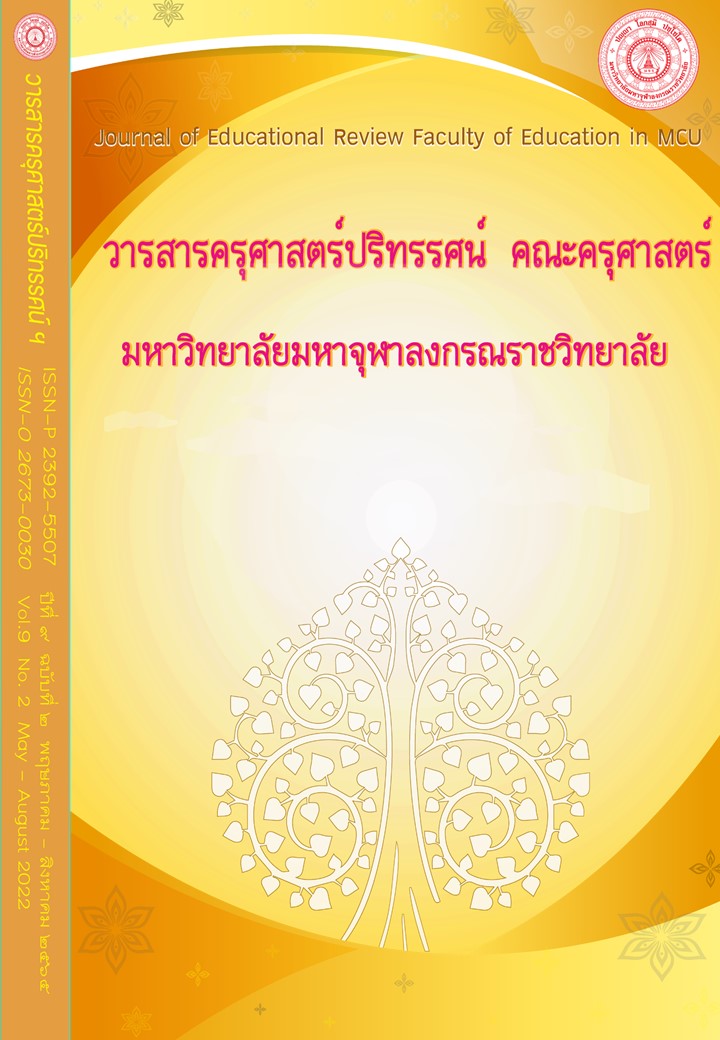DEVELOPING THE SPEAKING ABILITY FOR CAREER OF STUDENTS AT HIGH VOCATIONAL CERTIFICATE THROUGH ACTIVE LEARNING
Main Article Content
Abstract
The purposes of this research articles were 1) to compare the speaking ability for career of students at high vocational certificate before and after learning through active learning and 2) to study the satisfaction of students at high vocational certificate towards active learning to develop the speaking ability for career. The sample used in the study was the students at high vocational certificate currently studying in the first semester of academic year 2020. 30 students in one classroom at a vocational college in Nakhon Sawan province were selected using cluster random sampling. The research instruments consisted of 1) four lesson plans of Thai skill for career course 2) a test on the speaking ability for career, and 3) a questionnaire on the satisfaction of students at high vocational certificate towards active learning to develop the speaking ability for career. The statistics used for data analysis were mean, standard deviation and t – test for dependent samples. The findings showed that 1) the students’ speaking ability for career after the lesson was significantly higher than before the lesson at the .01 level and 2) the students were satisfied with learning using the study arrangement Know proactive at the most level Has a mean of 4.60 2) the students’ satisfactory on active learning was at highest level.
Article Details

This work is licensed under a Creative Commons Attribution-NonCommercial-NoDerivatives 4.0 International License.
ทัศนะและความคิดเห็นที่ปรากฏในบทความในวารสารฉบับนี้ถือเป็นความรับผิดชอบของผู้เขียนบทความนั้นเพียงผู้เดียว และไม่ถือเป็นทัศนะและความรับผิดชอบของกองบรรณาธิการ
กองบรรณาธิการขอสงวนสิทธิ์ในการคัดเลือกบทความลงตีพิมพ์และจะแจ้งให้เจ้าของบทความทราบหลังจากผู้ประเมินบทความตรวจอ่านบทความแล้ว
ต้นฉบับที่ได้รับการตีพิมพ์ในวารสารครุศาสตร์ปริทรรศน์ คณะครุศาสตร์ มหาวิทยาลัยมหาจุฬาลงกรณราชวิทยาลัย ถือเป็นกรรมสิทธิ์ของคณะครุศาสตร์ มหาวิทยาลัยมหาจุฬาลงกรณราชวิทยาลัย ห้ามนำข้อความทั้งหมดหรือบางส่วนไปพิมพ์ซ้ำ เว้นเสียแต่ว่าจะได้รับอนุญาตจากมหาวิทยาลัยฯ เป็นลายลักษณ์อักษร
References
กมล การกุศล. (2529). ทักษะและความรู้ทางภาษาไทย. กรุงเทพมหานคร: เนติกุลการพิมพ์.
คณะแพทยศาสตร์มหาวิทยาลัยสงขลานครินทร์. (2559). การเรียนรู้เชิงรุก (Active Learning). สารแพทยศาสตรศึกษา มอ. 2(1). 2-4.
ชมพูพราว มิ่งมงคล. (2559). การพัฒนาหน่วยการเรียนรู้เรื่องการพูดในงานอาชีพบูรณาการหลัก ปรัชญา เศรษฐกิจพอเพียง ระดับประกาศนียบัตรวิชาชีพ. วารสารวิจัยมหาวิทยาลัยเวสเทิร์น มนุษยศาสตร์และสังคมศาสตร์. 2(1). 1-10.
ไชยวัฒน์ อารีโรจน์ และสมพร ร่วมสุข. (2558). การพัฒนาแบบฝึกทักษะการพูดรายงานการศึกษาค้นคว้าสำหรับนักเรียนชั้นมัธยมศึกษาปีที่ 3. Veridian E-Journal, Silpakorn University ฉบับภาษาไทย สาขามนุษยศาสตร์สังคมศาสตร์ และศิลปะ. 8(2). 1824-1841.
ซารีนา สว่างวงษ์. (2560). การพัฒนาความสามารถด้านการพูดในโอกาสต่างๆ โดยใช้การสอนแบบบทบาทสมมุติวิชาภาษาไทยเพื่อสื่อสารในงานอาชีพของนักศึกษาระดับประกาศนียบัตรวิชาชีพชั้นสูง. รายงานการวิจัย. วิทยาลัยเทคโนโลยีพณิชยการราชดำเนิน.
ดวงหทัย เรืองนนท์. (2560). การพัฒนาความสามารถด้านการพูด โดยใช้การสอนแบบแสดงบทบาทสมมติในรายวิชาภาษาไทยเพื่ออาชีพ สาขางานธุรกิจค้าปลีกร้านสะดวกซื้อ ระดับประกาศนียบัตรวิชาชีพ ชั้นปีที่ 1 วิทยาลัยเทคโนโลยีปัญญาภิวัฒน์. รายงานการวิจัย. วิทยาลัยเทคโนโลยีปัญญาภิวัฒน์.
นพรัตน์ ใจกาษา. (2555). การพัฒนาความสามารถด้านการพูดในโอกาสต่างๆ โดยใช้การสอนแบบบทบาทสมมุติ วิชาศิลปะการพูด ของนักศึกษาระดับประกาศนียบัตรวิชาชีพ. รายงารการวิจัย. วิทยาลัยเทคโนโลยีพายัพและบริหารธุรกิจ.
เยาวเรศ ภักดีจิตร. (2557). Active Learning กับการพัฒนาผู้เรียนในศตวรรษที่ 21. แหล่งที่มา http://edu.nsru.ac.th/2011/files/knowlage/17-15-12_22-07-2014_2-3.pdf สืบค้นเมื่อ 8 เม.ย. 2564.
สถาพร พฤฑฒิกุล. (2555). คุณภาพผู้เรียน เกิดจากกระบวนการเรียนรู้. วารสารการบริหาร การศึกษา มหาวิทยาลัยบูรพา. 6(2). 1-3.
สำนักงานคณะกรรมการการอาชีวศึกษา. (2563). หลักสูตรประกาศนียบัตรวิชาชีพชั้นสูง พุทธศักราช 2563. แหล่งที่มา http://bsq.vec.go.th/th-th/หลักสูตร/ประกาศนียบัตรวิชาชีพชั้นสูง(ปวส)/หลักสูตรพศ2563./bspx สืบค้นเมื่อ 2 เม.ย. 2564.


